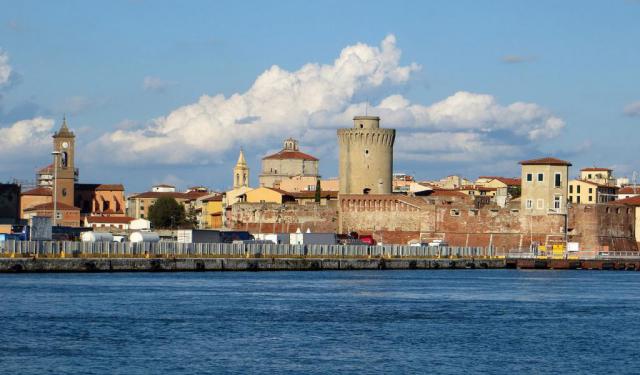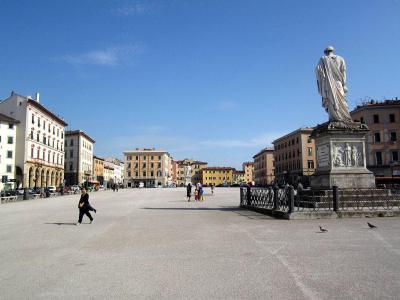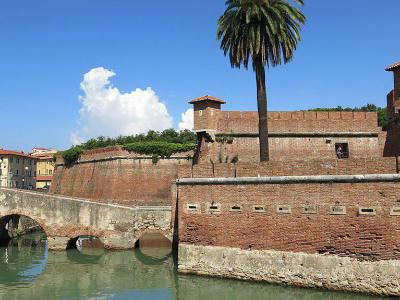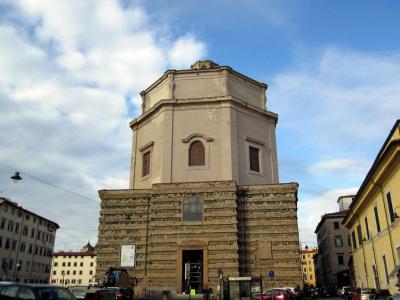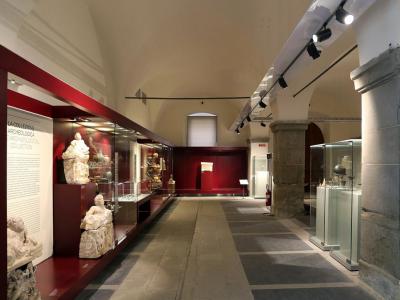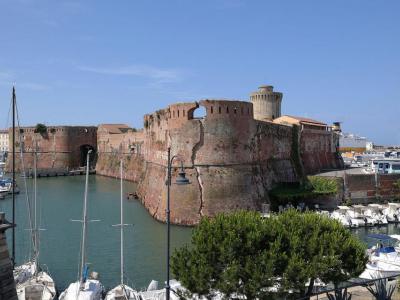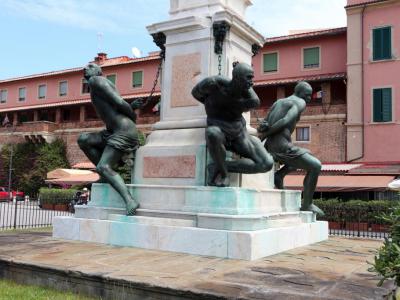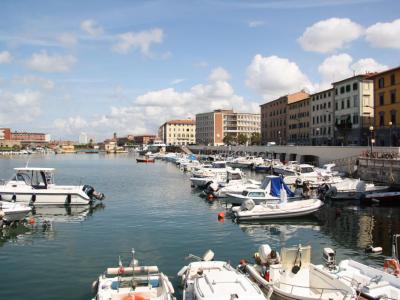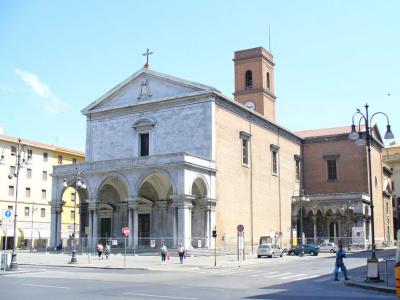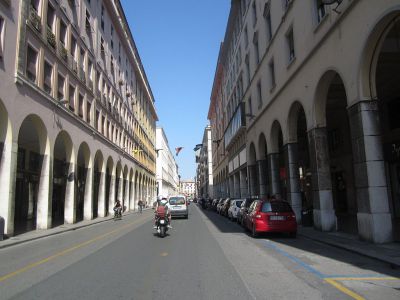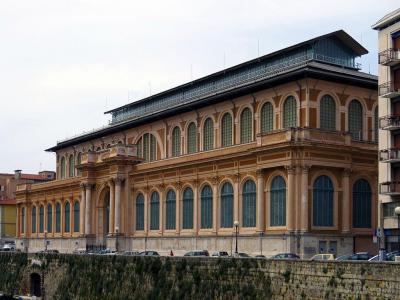Livorno Introduction Walking Tour (Self Guided), Livorno
In the early 19th century, Elizabeth Ann Seton, the first person born in the United States to be canonized a saint, had a spiritual epiphany while visiting Livorno. The city has had similar effects on visitors and immigrants. Under Medici rule, people of every ethnicity and calling would come to Livorno to find prosperity and tolerance.
There have been settlements in the Livorno area since neolithic times. In 1077 Matilda of Tuscany, one of the most powerful nobles in Italy at the time, built her keep there. In 1103 the Pisans built a rectangular fort there.
Pisa sold Livorno to the Viscounts of Milan in 1399. In 1405 it was sold to Genoa. Things began to happen with the arrival of the Medici of Florence in 1500. In the year 1534, the Old Fort was built. In 1577 Livorno became a fortified port enclosed within a pentagonal wall, surrounded by imposing bastions and canals.
In the late 16th century, Ferdinando I, Grand Duke of Tuscany, declared Livorno a free port. The policies of the Grand Duke attracted Turks, Persians, Greeks, Moors, Armenians, and especially Jews, who were fleeing Spain and Portugal. Livorno had emerged as an enlightened Renaissance city.
In March 1606, Ferdinando I elevated Livorno to the rank of city. The New Fortress, with bastions and canals, was built near the Old Fortress. By the late 18th century, the great European powers had their houses of trade in the city.
In the 18th and 19th centuries, there was a flourishing building of public parks, housing, and museums. There are eleven churches and meeting houses, and a synagogue. These sights include the Cathedral of Saint Francis, the Church of Saint Caterina, the Temple of the Dutch-German Congregation, and the Synagogue located in the Elijah Benamozegh Square.
Squares are to be visited, especially Republic Square and the Mascagni Terrace. New Venice, with its canals, should not be missed. The Old Fortress, the New Fortress, and the pentagonal perimeter of waterways hold the spirit of this imposing old seaport.
Livorno is a place of discovery. Elizabeth Ann Seton discovered her inner truth in Livorno. What doors will open here for the ordinary tourist? Come to discover them yourself.
There have been settlements in the Livorno area since neolithic times. In 1077 Matilda of Tuscany, one of the most powerful nobles in Italy at the time, built her keep there. In 1103 the Pisans built a rectangular fort there.
Pisa sold Livorno to the Viscounts of Milan in 1399. In 1405 it was sold to Genoa. Things began to happen with the arrival of the Medici of Florence in 1500. In the year 1534, the Old Fort was built. In 1577 Livorno became a fortified port enclosed within a pentagonal wall, surrounded by imposing bastions and canals.
In the late 16th century, Ferdinando I, Grand Duke of Tuscany, declared Livorno a free port. The policies of the Grand Duke attracted Turks, Persians, Greeks, Moors, Armenians, and especially Jews, who were fleeing Spain and Portugal. Livorno had emerged as an enlightened Renaissance city.
In March 1606, Ferdinando I elevated Livorno to the rank of city. The New Fortress, with bastions and canals, was built near the Old Fortress. By the late 18th century, the great European powers had their houses of trade in the city.
In the 18th and 19th centuries, there was a flourishing building of public parks, housing, and museums. There are eleven churches and meeting houses, and a synagogue. These sights include the Cathedral of Saint Francis, the Church of Saint Caterina, the Temple of the Dutch-German Congregation, and the Synagogue located in the Elijah Benamozegh Square.
Squares are to be visited, especially Republic Square and the Mascagni Terrace. New Venice, with its canals, should not be missed. The Old Fortress, the New Fortress, and the pentagonal perimeter of waterways hold the spirit of this imposing old seaport.
Livorno is a place of discovery. Elizabeth Ann Seton discovered her inner truth in Livorno. What doors will open here for the ordinary tourist? Come to discover them yourself.
How it works: Download the app "GPSmyCity: Walks in 1K+ Cities" from Apple App Store or Google Play Store to your mobile phone or tablet. The app turns your mobile device into a personal tour guide and its built-in GPS navigation functions guide you from one tour stop to next. The app works offline, so no data plan is needed when traveling abroad.
Livorno Introduction Walking Tour Map
Guide Name: Livorno Introduction Walking Tour
Guide Location: Italy » Livorno (See other walking tours in Livorno)
Guide Type: Self-guided Walking Tour (Sightseeing)
# of Attractions: 10
Tour Duration: 2 Hour(s)
Travel Distance: 3.0 Km or 1.9 Miles
Author: sabrina
Sight(s) Featured in This Guide:
Guide Location: Italy » Livorno (See other walking tours in Livorno)
Guide Type: Self-guided Walking Tour (Sightseeing)
# of Attractions: 10
Tour Duration: 2 Hour(s)
Travel Distance: 3.0 Km or 1.9 Miles
Author: sabrina
Sight(s) Featured in This Guide:
- Piazza Della Repubblica (Republic Square)
- Fortezza Nuova (New Fort)
- Chiesa di Santa Caterina (Saint Catherine Church)
- Museo della Città di Livorno (Livorno City Museum)
- Fortezza Vecchia (Old Fort)
- Monumento Dei Quattro Mori (Monument of the Four Moors)
- Porto Mediceo (Mediceo Port)
- Duomo di Livorno (Livorno Cathedral)
- Via Grande (Main Street)
- Mercato Centrale (Central Market)
1) Piazza Della Repubblica (Republic Square)
In 1575, Francesco I de Medici commissioned Bernardo Buontalenti to put forward a plan to turn Livorno from a glorified fishing village into a fortified town with a promising future. Buontalenti's solution encompassed the Old Fort and the original village. He presented a pentagonal system of walls, bastions, and canals.
In 1844 there was a need to connect the Buontalenti Pentagon of 1575 with the eastern part of town, which stretched well beyond the Royal Canal. The project would require the demolition of the city gate and modify the Royal Canal. Architect Luigi Bettarini had an idea: cover the canal.
Bettarini's concept was to put the canal in a vault. The vault cover is 789 feet long and 296 feet wide, and it became a public square. The waterway would still be navigable and would pass under the square. The popular name of the new place was Vault Square (Piazza del Voltone). In 1850 it was called the Square of Grand Dukes (Piazza del Granduchi). In 1859 it was named for Carlo Alberto, a leader of the first War of Independence.
In 1946, the square became the Republic Square (Piazza della Repubblica). It is furnished with 52 marble benches and 92 pillars reminiscent of hitching posts. There are two statues on opposite sides of the square; one of Grand Duke Ferdinand III, Grand Duke of Tuscany, and another of Leopold II, son of Ferdinand III and the last reigning Grand Duke of Tuscany.
Also located in the square is the Cisternino, a neoclassical structure of the 19th century built to provide the city with water.
In 1844 there was a need to connect the Buontalenti Pentagon of 1575 with the eastern part of town, which stretched well beyond the Royal Canal. The project would require the demolition of the city gate and modify the Royal Canal. Architect Luigi Bettarini had an idea: cover the canal.
Bettarini's concept was to put the canal in a vault. The vault cover is 789 feet long and 296 feet wide, and it became a public square. The waterway would still be navigable and would pass under the square. The popular name of the new place was Vault Square (Piazza del Voltone). In 1850 it was called the Square of Grand Dukes (Piazza del Granduchi). In 1859 it was named for Carlo Alberto, a leader of the first War of Independence.
In 1946, the square became the Republic Square (Piazza della Repubblica). It is furnished with 52 marble benches and 92 pillars reminiscent of hitching posts. There are two statues on opposite sides of the square; one of Grand Duke Ferdinand III, Grand Duke of Tuscany, and another of Leopold II, son of Ferdinand III and the last reigning Grand Duke of Tuscany.
Also located in the square is the Cisternino, a neoclassical structure of the 19th century built to provide the city with water.
2) Fortezza Nuova (New Fort) (must see)
Cosimo I and his son, Francesco I de Medici, commissioned a lot of work to Bernardo Buontalenti. Buontalenti was a renaissance man with many talents. He was a stage designer, architect, theater designer, military engineer, and artist. But best of all (to some), he invented Italian ice cream (gelato). In 1575 he made a plan to remake Livorno.
His plan was called the Buontalenti Pentagon. It enclosed the old city and its Old Fort within a pentagonal system of canals. Buontalenti's plan became the New Fort by adjusting the San Francesco Rampart and the Santa Barbara Rampart. The result vastly strengthened the military defensiveness of the town.
Buontalenti's project was further ameliorated by Don Giovanni de' Medici, Claudio Cogorano, and Alessandro Pieroni. The project was completed in 1604. Ferdinando II de Medici, Grand Duke of Tuscany, demolished part of the fortress in 1629 to facilitate the building of the New Venice and San Marco commercial centers of the city.
The New Fort was a military facility until the end of World War II. It had barracks for personnel and a chapel dedicated to the Immaculate Conception. The fort suffered severe damages in the war, and it was restored by 1972. Presently it serves as a public park and as an events venue.
His plan was called the Buontalenti Pentagon. It enclosed the old city and its Old Fort within a pentagonal system of canals. Buontalenti's plan became the New Fort by adjusting the San Francesco Rampart and the Santa Barbara Rampart. The result vastly strengthened the military defensiveness of the town.
Buontalenti's project was further ameliorated by Don Giovanni de' Medici, Claudio Cogorano, and Alessandro Pieroni. The project was completed in 1604. Ferdinando II de Medici, Grand Duke of Tuscany, demolished part of the fortress in 1629 to facilitate the building of the New Venice and San Marco commercial centers of the city.
The New Fort was a military facility until the end of World War II. It had barracks for personnel and a chapel dedicated to the Immaculate Conception. The fort suffered severe damages in the war, and it was restored by 1972. Presently it serves as a public park and as an events venue.
3) Chiesa di Santa Caterina (Saint Catherine Church)
The 14th-century Church of Saint Catherine of Siena has an unfinished facade. It is a Baroque edifice in the New Venice district of central Livorno. It stands on the Dominicans Square (Piazza dei Domenicani). It has a high octagon-shaped dome topped with a lantern. Dome and lantern sit on a rectangular base.
Saint Catherine was a mystic and writer who influenced Italian literature and the Catholic Church. She died in 1380 and was buried in the Basilica of Saint Mary of Minerva in Rome. She was canonized in 1461 and made a patron saint of Europe in 1999 by Pope John Paul II.
Construction of Saint Catherine Church began in 1720. The initial design was by Livorno architect Giovanni del Fantasia. The church was not inaugurated until 1753. The lantern tower was finally installed in 1869. The dome is 207 feet high.
Frescoes of the Evangelists, created in 1855, feature the cupola's interior. Over the main entrance is the Coronation of Mary. On the right of the entrance is the chapel of Saint Catherine of Siena.
Saint Catherine was a mystic and writer who influenced Italian literature and the Catholic Church. She died in 1380 and was buried in the Basilica of Saint Mary of Minerva in Rome. She was canonized in 1461 and made a patron saint of Europe in 1999 by Pope John Paul II.
Construction of Saint Catherine Church began in 1720. The initial design was by Livorno architect Giovanni del Fantasia. The church was not inaugurated until 1753. The lantern tower was finally installed in 1869. The dome is 207 feet high.
Frescoes of the Evangelists, created in 1855, feature the cupola's interior. Over the main entrance is the Coronation of Mary. On the right of the entrance is the chapel of Saint Catherine of Siena.
4) Museo della Città di Livorno (Livorno City Museum)
The Livorno City Museum examines the history of Livorno, a city of diversity where, historically, every visitor was welcomed. Its mission is well-focused. The exhibit collection is not sizable, but it holds fascinating artifacts. There are 9th-century farming implements of Tuscany and even the clothes worn by Guiseppe Garibaldi, one of Italy's "fathers of the fatherland."
The Museum is housed in the old Churches of the Assumption and Saint Joseph, connected by a renovated olive oil storage vault. The building complex is relatively new. Presently only the contemporary art section is open. The oil bottle space has housed temporary exhibitions since 2019.
The ground floor of the Bottini section holds collections from the Giovanni Fattori Civic Museum and the Labronica Library. There are about 600 objects in numismatic and archeological collections. The Etruscan and Roman artifacts are mainly from the collection of Enrico Chiellini. The medieval section has documents and frescoes.
The city's founding to the end of the 16th, 17th, 18th, and 19th centuries are covered up to the Risorgimento (19th-century movement for Italian unification that culminated in the creation of the Kingdom of Italy in 1861). Contemporary art is presented in the Church of the Assumption by artists Piero Manzoni, Emilio Vedova, Pino Pascali, Tancredi Parmeggiani, Giuseppe Uncini, and many others.
The Museum is housed in the old Churches of the Assumption and Saint Joseph, connected by a renovated olive oil storage vault. The building complex is relatively new. Presently only the contemporary art section is open. The oil bottle space has housed temporary exhibitions since 2019.
The ground floor of the Bottini section holds collections from the Giovanni Fattori Civic Museum and the Labronica Library. There are about 600 objects in numismatic and archeological collections. The Etruscan and Roman artifacts are mainly from the collection of Enrico Chiellini. The medieval section has documents and frescoes.
The city's founding to the end of the 16th, 17th, 18th, and 19th centuries are covered up to the Risorgimento (19th-century movement for Italian unification that culminated in the creation of the Kingdom of Italy in 1861). Contemporary art is presented in the Church of the Assumption by artists Piero Manzoni, Emilio Vedova, Pino Pascali, Tancredi Parmeggiani, Giuseppe Uncini, and many others.
5) Fortezza Vecchia (Old Fort) (must see)
Countess Matilda, Margrave of Tuscany in the 11th century, built a tower called the Keep of Countess Matilda. The tower was later incorporated into a fort built by the city of Pisa in 1377 called the Quadrature of the Pisans. These two structures were later the foundation of a new castle built by the Medici family, known now as the Old Fort.
Cosimo I de Medici started building the Old Fort in 1519. It was completed in 1534. The church of Saint Francis was built in the fortress in 1530. It was here, in 1606, that the ceremony proclaiming Livorno as a "city" took place.
There are three bastions and two gates. The landside bastion is called Ampolletta. The portside bastion is called Canaviglia. In the northeast is Capitana.
For centuries, the Old Fort has dominated the city skyline and is an iconic symbol of Livorno.
The Medici family made numerous modifications to the fort until the end of their dynasty in 1737. More changes were made during the Napoleonic era and later in the 19th century. Today, the Old Fort is managed by the Livorno Port Authority. The fort is open Tuesdays through Sundays from 9 am to 8 pm. Admission is free.
Cosimo I de Medici started building the Old Fort in 1519. It was completed in 1534. The church of Saint Francis was built in the fortress in 1530. It was here, in 1606, that the ceremony proclaiming Livorno as a "city" took place.
There are three bastions and two gates. The landside bastion is called Ampolletta. The portside bastion is called Canaviglia. In the northeast is Capitana.
For centuries, the Old Fort has dominated the city skyline and is an iconic symbol of Livorno.
The Medici family made numerous modifications to the fort until the end of their dynasty in 1737. More changes were made during the Napoleonic era and later in the 19th century. Today, the Old Fort is managed by the Livorno Port Authority. The fort is open Tuesdays through Sundays from 9 am to 8 pm. Admission is free.
6) Monumento Dei Quattro Mori (Monument of the Four Moors)
There was a sculptural fad in Italy in the 17th century that featured figures of prisoners and slaves, especially African slaves. The Four Moors statues in Livorno appear trendy that way. In 1617 Cosimo II commissioned Mannerist and Baroque sculptor Pietro Tacca to create a monument to Cosimo's father, Ferdinando I.
These four statues were meant to celebrate Roman aristocrat and general Marcantonio Colonna's role in the defeat of the Ottoman fleet at Lepanto in 1571. The joke was on Marcantonio. While he was sinking the Ottoman navy, the Ottoman army was sacking Cyprus.
Dressed as a Knight of San Stefano, Ferdinando stands on a high square pedestal in Micheli Square. A prisoner is chained at each corner of the base. One of them is African, perhaps a slave.
The Four Moors feature the four corners of the world. They also seem to tell the Medici's involvement in the slave trades in West Africa in the 17th century. Fernando II, the grandson of Fernando I, oversaw the monument's completion in 1626.
These four statues were meant to celebrate Roman aristocrat and general Marcantonio Colonna's role in the defeat of the Ottoman fleet at Lepanto in 1571. The joke was on Marcantonio. While he was sinking the Ottoman navy, the Ottoman army was sacking Cyprus.
Dressed as a Knight of San Stefano, Ferdinando stands on a high square pedestal in Micheli Square. A prisoner is chained at each corner of the base. One of them is African, perhaps a slave.
The Four Moors feature the four corners of the world. They also seem to tell the Medici's involvement in the slave trades in West Africa in the 17th century. Fernando II, the grandson of Fernando I, oversaw the monument's completion in 1626.
7) Porto Mediceo (Mediceo Port)
In 1572 Cosimo I commissioned Bartolomeo Ammannati to build fortified wharves and docks to connect within a quadrangular perimeter the Old Fortress with the Lighthouse of the Pisans (Fanale dei Pisani). Three structures, Ferdinando Port, Cosimo Port, and Mediceo Port, were constructed.
Ferdinando Port was 1,340 feet long. It extended from the harbor opening inlet to the Old Dock near the old fortress. The Cosimo Port is perpendicular to the Ferdinando Port, and it is 788 feet in length. The Cosimo Port ends at the Sassaia Fort, a blockhouse built over the Sassaia reef.
The Mediceo Port is an extension of Cosimo Port extending from the Sassaia reef, northwest, and parallel to the coast. It is 1,544 feet long and 821 feet wide. At the end of the port is the Wharf Fortress (Fortezza del Molo), once used to guard the port entrance. Mediceo Port could accommodate as many as 140 deep-sea vessels in its heyday.
Ferdinando Port was 1,340 feet long. It extended from the harbor opening inlet to the Old Dock near the old fortress. The Cosimo Port is perpendicular to the Ferdinando Port, and it is 788 feet in length. The Cosimo Port ends at the Sassaia Fort, a blockhouse built over the Sassaia reef.
The Mediceo Port is an extension of Cosimo Port extending from the Sassaia reef, northwest, and parallel to the coast. It is 1,544 feet long and 821 feet wide. At the end of the port is the Wharf Fortress (Fortezza del Molo), once used to guard the port entrance. Mediceo Port could accommodate as many as 140 deep-sea vessels in its heyday.
8) Duomo di Livorno (Livorno Cathedral)
The Livorno Cathedral is also known as the Cathedral of Saint Francis of Assisi, Mary Mother of Jesus, and Julia of Corsica. Julia, a patron saint of Livorno, was martyred in Cosica by Vandals in the 5th century. The cathedral is within the Buontalenti Pentagon on the south side of the Main Square (Piazza Grande).
Construction began in 1581. The facade is plain. The lower half has a porch with three arches supported by four Doric columns. The upper part of the facade has a central rectangular window within a recessed arch. Arches on either side are filled in and framed with pilasters. Restorations were made after World War II.
The original church had a rectangular plan with a single nave. It was changed to a cross plan when two chapels were added in 1716. The left chapel is dedicated to the Eucharist (the Christian service in which bread and wine are consecrated and consumed). The right chapel, dedicated to the Immaculate Conception, was built in 1727.
The Livorno Cathedral was almost destroyed, by Allied bombs, in World War II. It was rebuilt close to the original, except for the additions to the facade and transepts. The cathedral was reconsecrated in 1952.
When visiting the cathedral, make sure you see the painting "Christ Crowned with Thorns" by the early renaissance Italian painter Fra Angelico in the Chapel of the Eucharist. Fra Angelico is described, by the famous Italian art historian Giorgio Vasari, as having "a rare and perfect talent." He is known for his beautiful fresco paintings.
Construction began in 1581. The facade is plain. The lower half has a porch with three arches supported by four Doric columns. The upper part of the facade has a central rectangular window within a recessed arch. Arches on either side are filled in and framed with pilasters. Restorations were made after World War II.
The original church had a rectangular plan with a single nave. It was changed to a cross plan when two chapels were added in 1716. The left chapel is dedicated to the Eucharist (the Christian service in which bread and wine are consecrated and consumed). The right chapel, dedicated to the Immaculate Conception, was built in 1727.
The Livorno Cathedral was almost destroyed, by Allied bombs, in World War II. It was rebuilt close to the original, except for the additions to the facade and transepts. The cathedral was reconsecrated in 1952.
When visiting the cathedral, make sure you see the painting "Christ Crowned with Thorns" by the early renaissance Italian painter Fra Angelico in the Chapel of the Eucharist. Fra Angelico is described, by the famous Italian art historian Giorgio Vasari, as having "a rare and perfect talent." He is known for his beautiful fresco paintings.
9) Via Grande (Main Street)
Main Street (Via Grande) Livorno’s vibrant shopping artery, extends from the Medicean Port to Republic Square. As one of the city’s major thoroughfares, it is a hub for both locals and tourists, particularly those arriving via cruise ship. This bustling street is lined with familiar high-end clothing stores, shoe shops, and various outlets for jewelry and perfumes, making it a prime destination for those seeking retail therapy. International brands such as Benetton, Max Mara, and Zara dominate the landscape, though a handful of local boutiques, cafes, and smaller shops offer a more personalized shopping experience.
The street is hard to miss, especially for cruise visitors, as shuttle buses drop passengers right in the heart of Via Grande. From here, it’s an easy stroll to nearby attractions, including the upscale Ricasoli Street, famous for its luxury boutiques, and Piazza Grande. A supermarket, Conad, is conveniently located at the west end of the street.
Operating hours for most stores are from 9 am to 1 pm, followed by an afternoon break, with doors reopening from 4 pm to 8 pm. Sundays and public holidays typically see the shops closed, although the first Sunday of each month is an exception, when most shops open in the afternoon (except during July and August). In August, many smaller shops close for a few days due to local holiday traditions.
With its mix of international brands and local charm, Via Grande serves as the perfect starting point for exploring Livorno’s shopping district, offering a blend of modern retail and traditional Italian flair.
The street is hard to miss, especially for cruise visitors, as shuttle buses drop passengers right in the heart of Via Grande. From here, it’s an easy stroll to nearby attractions, including the upscale Ricasoli Street, famous for its luxury boutiques, and Piazza Grande. A supermarket, Conad, is conveniently located at the west end of the street.
Operating hours for most stores are from 9 am to 1 pm, followed by an afternoon break, with doors reopening from 4 pm to 8 pm. Sundays and public holidays typically see the shops closed, although the first Sunday of each month is an exception, when most shops open in the afternoon (except during July and August). In August, many smaller shops close for a few days due to local holiday traditions.
With its mix of international brands and local charm, Via Grande serves as the perfect starting point for exploring Livorno’s shopping district, offering a blend of modern retail and traditional Italian flair.
10) Mercato Centrale (Central Market)
Central Market is the main market in Livorno. After the unification of Italy in the 19th century, several major cities, Livorno among them, went through a renewal period called "Risanamento" (Remediation). The market was the result of the rage for iron and glass that followed.
Construction started in 1889 after the demolition of some 17th-century fortifications. The work was completed in 1904. The facade is 312 feet long, overwhelming the Royal Canal. It is rectangular, with an entrance on each of its four sides. The Main Entrance is at the end of the Street of Our Lady (Via della Madonna).
Arched windows line the side walls flanked with Corinthian columns and pilasters. The upper floor is a smaller similar structure, a double roof centered on the ground floor roof. The main hall of the interior is graced with caryatids. The arched windows on the top walls and the double roof afford generous light for the high-ceilinged market rooms.
In the main hall, shops display the foods of Tuscany for the most part. Two other rooms sell fish and vegetables. The fish room has 22 marble counters. The veggie room has 22 vegetable stands. The total market capacity is 230 stands or stalls and 24 shops. In fact, Livorno's Central Market is the second largest indoor market in Europe, second only to the Boqueria Market in Barcelona.
Livorno has a well-deserved reputation for its religious tolerance. Jews were free to live within the walls, escaping the kind of persecution that they encountered in other parts of Europe. The Jewish influence can be found today in the kosher fish and tomato-based dishes seen in the market.
Construction started in 1889 after the demolition of some 17th-century fortifications. The work was completed in 1904. The facade is 312 feet long, overwhelming the Royal Canal. It is rectangular, with an entrance on each of its four sides. The Main Entrance is at the end of the Street of Our Lady (Via della Madonna).
Arched windows line the side walls flanked with Corinthian columns and pilasters. The upper floor is a smaller similar structure, a double roof centered on the ground floor roof. The main hall of the interior is graced with caryatids. The arched windows on the top walls and the double roof afford generous light for the high-ceilinged market rooms.
In the main hall, shops display the foods of Tuscany for the most part. Two other rooms sell fish and vegetables. The fish room has 22 marble counters. The veggie room has 22 vegetable stands. The total market capacity is 230 stands or stalls and 24 shops. In fact, Livorno's Central Market is the second largest indoor market in Europe, second only to the Boqueria Market in Barcelona.
Livorno has a well-deserved reputation for its religious tolerance. Jews were free to live within the walls, escaping the kind of persecution that they encountered in other parts of Europe. The Jewish influence can be found today in the kosher fish and tomato-based dishes seen in the market.
Walking Tours in Livorno, Italy
Create Your Own Walk in Livorno
Creating your own self-guided walk in Livorno is easy and fun. Choose the city attractions that you want to see and a walk route map will be created just for you. You can even set your hotel as the start point of the walk.
Livorno Seafront Walk
When the weather permits and you fancy a walk, whilst in Livorno, taking a stroll along the local seafront is a good idea. The curvy walkway, running along the coast, south of the city, is dotted with numerous points of interest. The first of them, marking the outset of the long stretch of intriguing sights further ahead, is the former Orlando shipyard.
Practically next door to it is the... view more
Tour Duration: 2 Hour(s)
Travel Distance: 2.3 Km or 1.4 Miles
Practically next door to it is the... view more
Tour Duration: 2 Hour(s)
Travel Distance: 2.3 Km or 1.4 Miles
The Most Popular Cities
/ view all
